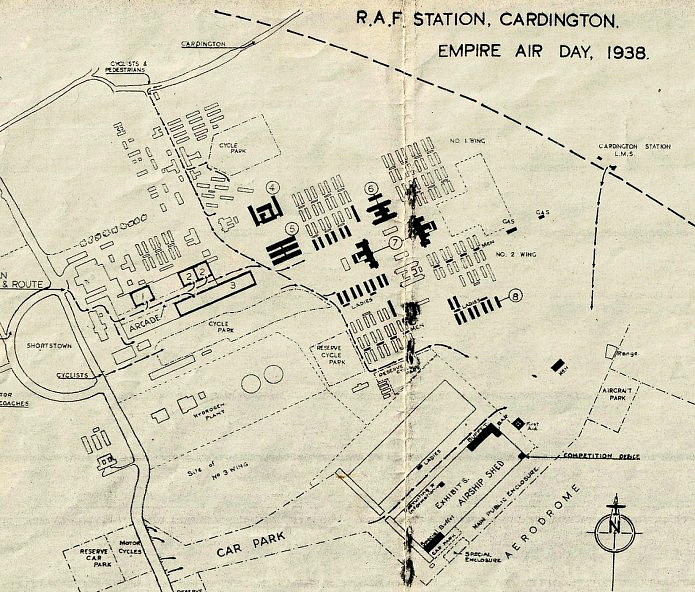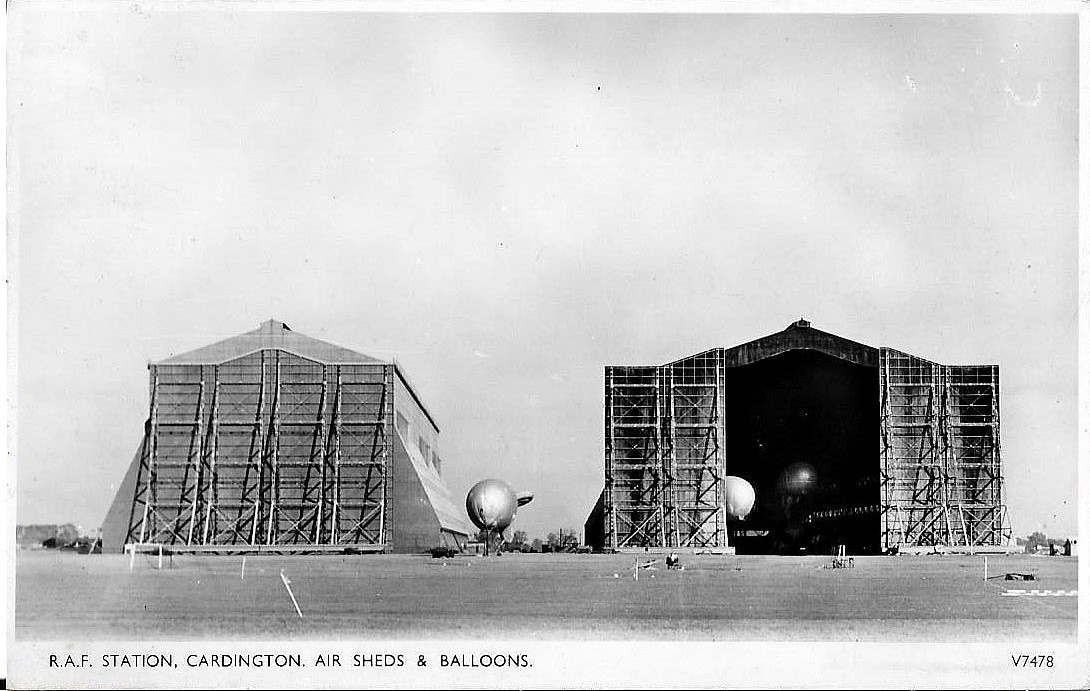Cardington
CARDINGTON: Military/Government Airship Construction Station.
Note: All four of these pictures were obtained from Google Earth ©
Of interest in recent years, (see fourth picture above), is the runway: 09/27 390 grass
Aerodrome in WW2. Later airship factory & base and civil airfield
Note: Pictures by the author
Military users: WW1: Leased to Short Bros for construction of rigid airships from 1917 to 1919
WW2: RAF Used by Harvards based with TADU, also used by Avro Ansons
Manufacturing: Pre 1940: Royal Airship Works
Post 1945: Advanced Technologies (Airships)
Location: Roughly 2nm SSE of Bedford town centre
Site area: WW1: 1064 acres 2880 x 210
Runways: WW2: Grass airfield?
Period of operation: 1914 to present day
This fabulous picture was scanned from 'The Big Book of Flight' by Rowland White published in 2013 by Transworld Publishers. It is a really great book, (a birthday present from my daughter), which is aimed to be read by people of all ages, to share his love of aviation history. And what a 'tour de force' it is - I have read it twice, and dip into into it from time to time for a treat.
NOTES: Without any doubt this site is exceptional. Indeed the two airship hangars still provide a major navigational feature for anybody flying VFR in the region. Some claim that CARDINGTON Royal Airship Works is the home of the British airship. Perhaps so? The R31, R32, R37, R.38 and R.100 were built here, as was the infamous R.101.
It seems that construction of the first hangar, 700ft long, 254ft wide and 145ft high began in 1916 when Short Bros, with a £110,000 loan from the British Government, began and they continued until 1919. To confuse the issue it appears that in 1917 the Cardington Naval Aircraft Works opened here, and they took control of the site from Short Bros in 1919. The second hangar, suitably called No.2 South Hangar, was constructed in 1928.
THE R100
The R100 left from here for Montreal landing at Saint Hubert airport, commanded by Major G H Scott , (actually a US and Canada tour if a flight over the Niagra Falls is taken into account ), on the 29th July 1930. (Or on the 20th according to other probably mistaken reports?), taking 78hrs 49min. The return flight took 57hrs 30mins arriving back on the 16th August.
THE R101
14th Oct 1929. 1st flight of H.M. Airship R.101 G-FAAW. About a week later the R.101 completed a ‘shake-down’ or proving flight of just over thirty hours and 1,800 miles flying up the east coast to Edinburgh, across to Glasgow, then Belfast, Angelsey, Rhyl, Chester and Lichfield before returning to CARDINGTON. It would seem that although the press hailed this as a magnificent achievement the crew were secretly far from happy as the general performance was way below expectations. In fact almost a year was spent trying to overcome a considerable list of problems including handling, airframe issues and lifting capability; and these were never properly resolved.
The R.101 lifted off from CARDINGTON at 18.36 on the 4th October 1930 and some reports say it was considerably overweight. It crashed in a storm at Beauvais north of Paris at 02.09 on the 5th and 48 of the 54 crew and passengers perished in the ensuing fire. Perhaps the greatest loss was to British civil aviation as Sir W. Sefton Brancker, the Director of Civil Aviation was on board. This remarkable man was quite possibly the greatest enthusiast and exponent for civil aviation this country has ever known.
It is well worth reading up the history about this ill-fated airship as in many respects it seemed doomed almost from the start and the concerns of the crew, including Flight Lieutenant H. Carmichael Irwin, (sometimes spelt Irvin), the R.101s Captain, were ignored and over-ridden until the bitter end when it ‘crashed’ in France. From the evidence now compiled it appears the accident was not a ‘crash’ as such, but an extremely unfortunate set of circumstances which arose during a forced landing. The forward speed at the point of impact was barely 14mph.
Just as in the Hindenberg disaster in the USA the hydrogen carried as the lifting agent was NOT the cause of the disaster. But once a fire has started, the presence of so much hydrogen must invariably lead to a quick and immense conflagration.
This disaster put paid to any British plans for giant airship operation which is a great shame because, it would seem, the R.100 privately built at HOWDEN by Vickers was altogether a much better design. This said it appears neither British airship could be compared with the considerably superior Zeppelin designs. And it appears, the Graf Zeppelin visited CARDINGTON in 1930.
A MICHAEL T HOLDER GALLERY
Note: The newspaper article about the visit by Sir Alan Cobham was published in the Bedfordshire Times and Independent on the 17th May 1929.
A VISIT BY SIR ALAN COBHAM
On the 16th May 1929 Sir Alan Cobham landed here in the ten-seater DH60 'Giant Moth' G-AAEV - named 'Youth of Britain'. Starting at Oxford the day before, the tour, named the Municipal Aerodrome Campaign, was originally planned to visit 107 venues. The aim being to raise air-mindedness and encourage the construction of aerodromes and regional airports.
In the end, after a couple of crashes and other set-backs, he still managed to visit around 95 venues - a still quite magnificent achievement - especially bearing in mind that the majority of venues were unprepared landing areas.
FLYING CIRCUS VENUE
Venue, (15th April 1932), for Sir Alan Cobham’s National Aviation Day Display Tour
THE MIKE CHARLTON GALLERY
In September 2017 Mike Charlton very kindly sent me these images from his amazing collection of aviation postcards. See www.aviationpostcard.co.uk
These pictures are especially interesting as they appear to show a variety of 'Gate Guardians' after WW2. The first picture shows the de Havilland Vampire F3 VT812 which was on display here, it appears, from 1961 to 1964 .
The second picture of the Supermarine Attacker VV106/7175M is of especial interest as it was one of the Attackers fitted with swept wings to investigate this 'new' concept for high speed flight. It appears that VV106 was withdrawn from service in 1955 and was given the marking 7175M (which it wears in this picture) after becoming a Technical Training airframe. What also intrigues me is why a Royal Navy Fleet Air Arm type should appear at a RAF Station?
The Attacker was the first jet to enter service with the Fleet Air Arm and I am trying hard to think of another British military jet which entered service as a 'tail-dragger'. It seems reasonable to suppose that this Attacker was replaced by the Vampire VT812?
The third picture raises a couple of questions: such as when was it taken? Clearly seen in the open hangar is a typical WW2 barrage balloon. But why was it here and what was going on?
The fourth picture of the Vickers-Supermarine Spitfire MK XX1 (F21), LA255, raises a few questions. Some research appears to reveal it served as a 'Gate Guardian' from 1952 to 1962. Perhaps this is correct and the Attacker served as a secondary exhibit? Any advice will be most welcome.
Note: In January 2020 Mike Charlton kindly sent me this additional picture from a postcard. Undated, I wonder when this picture was taken?
A STORAGE FACILITY
In 1977 CARDINGTON was used quite extensively as a storage facility. For example the Avro 504K G-ABBA was based here belonging to the RAF Museum. Other aircraft stored here were the Miles Hawk Major G-ADMW, DH.89A Dragon Rapides G-AHED, G-AITB, G-AITFand G-AJLR. Plus the Miles Messenger G-ALAH of the Aeroplane Collection, the Bristol 173 G-ALBN and Bristol 171 G-ALSP both of the RAF Museum, plus F-BMFI and VH-ALB. Presumably most of these weren’t airworthy? However, I assume the Airborne Industries airship G-BAWL possibly was operational?
AEROSPACE DEVELOPMENTS
Be that as it may, the news was, in 1977 that Aerospace Developments had started construction of their airship, the AD-500, with many advance orders. What happened to this venture? This was said to be the rebirth of airship production at CARDINGTON since the R.101 crashed at Beavais in 1930. Can anybody give the start and end dates for this attempted revival period of airship production at CARDINGTON?
THE TWO MASSIVE HANGARS
The two massive airship hangars are still in existence today and certainly have provided me with a valuable navigation feature as they can be seen from many miles away. In 2006/7 one hangar was a conservation project, the other being used as a film studio which I have visited delivering motion control equipment in my truck.
A NEW DEVELOPMENT
On the 17th August 2016, the massive Airlander 10 'airship' built by Hybrid Air Vehicles, flew for the first time. It is 302 feet (92m) long, and it is claimed it can stay aloft for days at a time, with a maximum cruise speed of 80 knots.
Unfortunately, after its second test flight on the 24th August it crashed on landing, fortunately with no injuries to the crew, but badly damaging the cockpit area.
Terry Clark
This comment was written on: 2018-01-05 03:37:01In 1961, my older brother had to attend pre-entry testing for training as an RAF Boy Entrant at Cardington (on successful completion of which he started training at Cosford). There was a Nissen Hut in the station car park at Bedford used as a reception centre for this. Years later, one of my colleagues at Farnborough told me he went to ATC camp at Cardington and they operated Chipmunks off the grass area to fly cadets. Ref the WW2 barrage balloon; these are/were used by the met office for atmospheric sampling, sometimes going as high as 10,000ft (unmanned) carrying instrument packages.
jhon bufton
This comment was written on: 2020-03-26 09:24:59I worked on this camp in the 60's for the MPBW. The RAF at this point were producing gases for aircrew and a few balloon units. The storage sheds then were an absolute dream for any aviation historian with bits of the R100, a Spitfire donated by some Maharaja and a thousand other relics. At the bottom of the hill down towards the hangers was the old Shorts building, a massively built concrete structure which originally had been built as a test facility for the airship engines, now i see long gone. In the photograph of the front gate the wooden building to the right of the main building was the Officers Mess at that point.
Colin Franklin
This comment was written on: 2020-09-18 17:23:59Does anybody have any photos of the internal railway system at RAF Cardington? I do know that it had its own one-road shed as I observed it many years ago with the gondola from the Skyship 500 outside during an official LCGB visit.
We'd love to hear from you, so please scroll down to leave a comment!
Leave a comment ...
Copyright (c) UK Airfield Guide





































